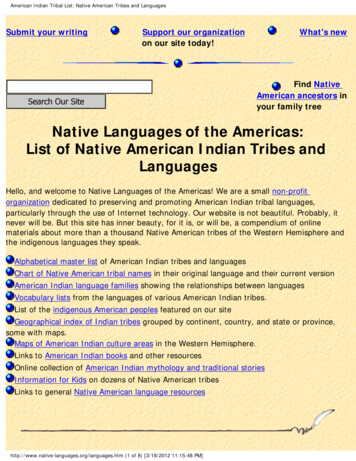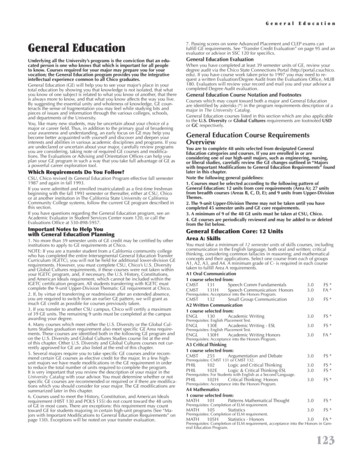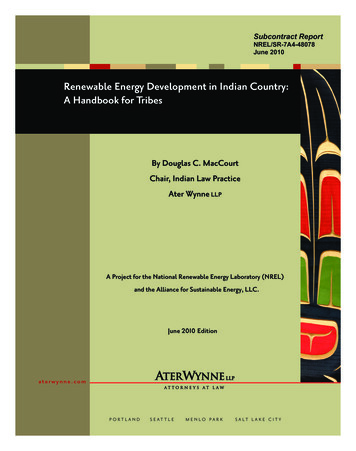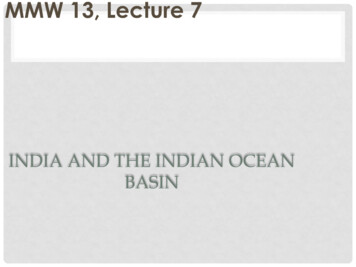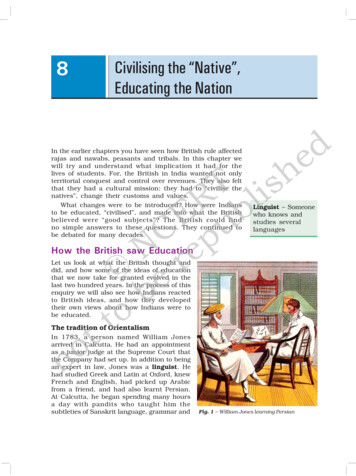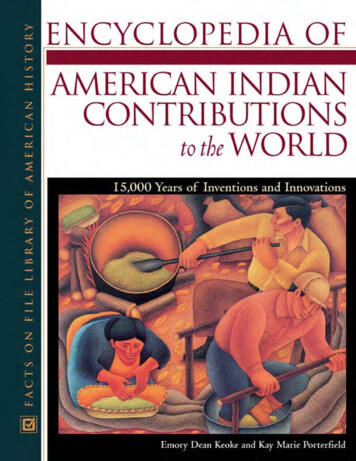
Transcription
American Indian Contributionsto the Worldp
American Indian Contributionsto the World15,000 YEARS OF INVENTIONS AND INNOVATIONSpEMORY DEAN KEOKEANDKAY MARIE PORTERFIELD
American Indian Contributions to the WorldCopyright 2003, 2002 by Emory Dean Keoke and Kay Marie PorterfieldMaps pages 316–327 Carl Waldman and Facts On File, Inc.Maps pages 328–332 Facts On File, Inc.All rights reserved. No part of this book may be reproduced or utilized in anyform or by any means, electronic or mechanical, including photocopying,recording, or by any information storage or retrieval systems, without permissionin writing from the publisher. For information contact:Checkmark BooksAn imprint of Facts On File, Inc.132 West 31st StreetNew York NY 10001The Library of Congress has cataloged the hardcover edition as follows:Keoke, Emory Dean.Encyclopedia of American Indian contributions to the world : 15,000 yearsof inventions and innovations / Emory Dean Keoke and Kay Marie Porterfield.p. cm.Includes bibliographical references and index.ISBN 0-8160-4052-4 (hc)—ISBN 0-8160-5367-7 (pbk)1. Indians—Encyclopedias. 2. Inventions—Encyclopedias.3. Technological innovations—Encyclopedias. I. Porterfield, Kay Marie.II. Title.E54.5 .K46 2001970’.00497’003—dc2100-049034Checkmark Books are available at special discounts when purchased in bulkquantities for businesses, associations, institutions, or sales promotions. Please callour Special Sales Department in New York at (212) 967-8800 or (800) 322-8755.You can find Facts On File on the World Wide Web at http://www.factsonfile.comText design by Joan M. ToroCover design by Cathy RinconMaps by Dale WilliamsPrinted in the United States of AmericaVB FOF 10 9 8 7 6 5 4 3 2 1This book is printed on acid-free paper.
pFor my uncle Francis X. Hairy Chin, for starting me on this project;for my grandson Jason Keoke, whom I hope will have a better chanceto learn about American Indians than I did; and for Glen Yellow Bird,a man who always called me brother and whom I respected tremendously.—EDKFor Hannah Marie White Elk and for Ward E. Porterfield,who first taught me the difference between corn and beans.—KMP
The information in this book on the use of herbal and other natural remediesemployed by Native Americans and others is strictly for educational purposes.Readers should seek professional medical advice if they are considering trying anyof these remedies. The authors and publisher disclaim liability for any loss or risk,personal or otherwise, resulting, directly or indirectly, from the use, application, orinterpretation of the contents of this book.
CONTENTSpPREFACEixATOZ ENTRIESxvAPPENDIX A: TRIBES ORGANIZED BY CULTURE AREA311APPENDIX B: MAPS315GLOSSARY333CHRONOLOGY336BIBLIOGRAPHY AND FURTHER READING340ENTRIES BY TRIBE, GROUP, OR LINGUISTIC GROUP344ENTRIES BY GEOGRAPHICAL CULTURE AREA355ENTRIES BY SUBJECT362GENERAL INDEX367
PREFACEpWhat follows is a collection of contributions American Indian peoples havemade to the world. The word contribution is defined in The AmericanHeritage College Dictionary, Second Edition as “to give to the common fund or common purpose.” American Indians, from the Arctic Circle to the tip of South America, donated many gifts to the world’s common fund of knowledge in the areas ofagriculture, science and technology, medicine, transportation, architecture, psychology, military strategy, government, and language. These contributions take theform of inventions, processes, philosophies, and political or social systems. For themost part until the late 19th century, they remained unrecognized outside of thedisciplines of anthropology and archaeology. People throughout the world enjoyedthe fruits of indigenous American invention—such as rubberized raincoats, POPCORN, HAMMOCKS, and the drug QUININE—without being aware of their origin. At the same time textbooks, novels, and later movies and television portrayedthe first people of the Americas as primitives who were incapable of complexideas or inventions.Immediately after initial contact, Europeans from Christopher Columbus onwrote detailed descriptions about the accomplishments of the American Indiansthey encountered. Often they judged these accomplishments as being superior toanything in the Old World. Nevertheless, as a general rule, within 20 years aftercontact, conquistadores and colonists alike denied that the American Indians,whom they had begun to call “savages,” were responsible for these discoveries. Theywere so certain that Indian people were incapable of discovering the technologythey had encountered that, soon after the voyages of Columbus, they beganspreading rumors throughout Europe that the Americas were the site of settlementfor a lost colony of Christians or a lost tribe of Israelites. This rumor persisted inpopular culture until well into the 20th century.Later colonists and missionaries in the North American Southeast speculatedthat the Cherokee, whose way of life they deemed “civilized,” spoke a version ofHebrew or Phoenician, “proving” that these people were not Indian. Early European settlers in what would become Virginia theorized that a Welsh prince,Madoc, had wandered to the New World in the 13th century to give the Indianpeople the technology they possessed. When non-Indians viewed the mounds atCahokia, an enormous city built by Mississippian people that had flourished inabout A.D. 1100 near the site of modern St. Louis, they refused to believe that Indian people had created the city. Anthropologists determined that it had been builtix
XPREFACEby an early vanished race of people that had been vastly superior and completelyunrelated to the Indians living at the time of contact.By the 1800s American history textbooks denied that Indians possessed evena modicum of intelligence or knowledge. This extreme change of attitude aboutAmerican Indian intellect was not coincidental. Nor was it based on the reality ofAmerican Indian intellectual accomplishments, which included an Andean roadsystem more extensive than that of Rome and sophisticated Mesoamerican andNorth American surgical techniques unheard of in the Old World. Rather, it wasgrounded in a real and immediate need to justify conquest with a stroke of thepen. “The belief that ‘civilization’ and ‘Indianness’ were inherently incompatible,and the failure of Europeans to understand the nature of tribal society, meant thatthere was little possibility of peaceful coexistence and that the image of the Indianas ‘savage,’ was used to rationalize conquest and conversion,” wrote Colin G. Calloway in Crown and Calumet: British-Indian Relations, 1783–1815.A similar process had taken place in Mesoamerica and in South America inearlier centuries as Spanish conquistadores burned libraries and priests bannedeven agricultural products such as AVOCADOS and the seed crop AMARANTH because they believed these kept the Indians they sought to convert tied to their “savage ignorance.” In order to justify the theft of American Indian ideas, inventions,and land, it was necessary to portray them as less intelligent and less human thanEuropeans. Use of the terms savages and heathens were first steps in dehumanizingAmerican Indians; eventually they were equated with animals.In 1861 American author Mark Twain rode the overland stage across what isnow Utah and Nevada. During his journey he encountered what are sometimes referred to as “Digger” Indians—the Shoshone. As a reporter, he recorded his perceptions that the Shoshone were “. . . the wretchedest type of mankind I haveever seen up to this writing.” His offhanded condemnation, along with those ofcountless other authors, led to a stereotype believed by generations of Americans—that the Shoshone and all Indian people had no redeeming social value. This impression is far from the truth. The Shoshone—who invented an effective form oforal CONTRACEPTION years before western medicine came up with one in themid-20th century—were also masters of ORTHOPEDIC TECHNIQUES. They usedASEPSIS, the practice of creating a sterile field during SURGERY, hundreds of yearsbefore this was done in western medicine.In 1923 Halleck’s History of Our Country, a popular elementary school text,taught a generation of children, “. . . the Indian was ignorant, and no great teacherhad come to him. He had few tools, and most of these were of wood or stone. Wecould scarcely build a hen coop to-day with such tools.”By the 1980s and 1990s, some school textbooks still showed only a little improvement over Halleck. According to the 1981 edition of A History of the UnitedStates published by Ginn and Company that was still approved for use in Washington State schools in 1993, “North of Mexico, most of the people lived in wandering tribes and led a simple life. North American Indians were mainly huntersand gatherers of wild food. An exceptional few—in Arizona and New Mexico—settled in one place and became farmers.”In truth, two of the four places where AGRICULTURE independently originated in the world are located in the Americas. After contact the introduction ofcrops that American Indians had cultivated for hundreds of years provided a nutritional boost that caused a population boom in Europe, which had not fully recovered from the bubonic plague two centuries before. Today POTATOES, CORN,and MANIOC have become a major source of nutrition for people around theglobe.The textbook World Cultures: A Global Mosaic published by Prentice Hall in1993 implies that the WHEEL was invented only one time with the words, “Gradually, the knowledge of the wheel spread around the globe, changing cultures everywhere.” No mention is made that the Maya crafted wheeled figurines and
PREFACEthat, given the absence of suitable draft animals in the Americas, wheeled vehiclesas a mode of transportation would have been inappropriate technology.Although most textbooks no longer begin their discussion of the history ofthe Americas in 1492 when Christopher Columbus landed on the island of Hispaniola, some contain only a few pages on precontact American Indian history.The 1991 edition of A More Perfect Union published by Houghton Mifflin devotesone page to American history before European exploration. The United States: Pastto Present published by D.C. Heath and Company in 1989 does not cover precontact history at all.Authors writing for adults about American Indians before European contactare not immune from perpetuating misconceptions. Erich Van Daniken’s popularbooks, beginning with Chariots of the Gods in the 1970s and continuing with TheArrival of the Gods: Revealing the Alien Landing Sites of Nazca published in 1998,continue to perpetuate the stereotype that the indigenous people of the Americaswere not capable of the engineering feats they accomplished.Other authors, including Jack Weatherford in Indian Givers: How the Indians of the Americas Transformed the World, assert that, along with agricultural, medical, and technological gifts, American Indians presented Europeans with syphilis.He writes: “The accumulation of archaeological and medical evidence has slowlyled to the conclusion that in addition to all the medicines that America gave theworld, it contributed at least one dreaded disease—syphilis. The Old World hadno knowledge of syphilis prior to 1493. . . .”The facts contradict this conclusion. European accounts from the 1400sdocument that this sexually transmitted disease was present in Europe at least twodecades before Columbus landed in the Americas. (In 1493 Spaniards were alreadycalling it the “French malady.”)Throughout history those who hold power have used it to create definitionsthat marginalize people who do not hold power. At the same time that they havemade use of the technologies and resources of those they dominate, they have minimized them or failed to acknowledge their originators. Sophie Coe, author ofAmerica’s First Cuisines, describes how American Indians failed to receive creditfor animal and plant domestication. “The fact that many millennia of patient observations, considered economic decisions, and hard physical work were necessary to assemble the New World crop inventory was brushed aside.”A case can be made that contact with American Indians actually served as oneof the catalysts for the Scientific Revolution in Europe. In 1571 King Philip II ofSpain commissioned physician Francisco Hernandez to document the medicinalseeds, plants, and herbs that the Aztec used. Spanish physicians exploring indigenous American cures soon published three textbooks based on this information including one on surgery. The study of American Indian medicines and plants thatAmerican Indians cultivated for food sparked an unprecedented burst of intellectual curiosity in Europe. The flow of information from Meso- and South Americaslowed dramatically when a 1577 Spanish decree ordered the destruction of notonly American Indian books but also those written by Spaniards about AmericanIndians. However, once the door to intellectual inquiry had been opened, it couldnot be completely shut.Although more than 200 of the plants that American Indians used as remedies became part of the U.S. Pharmacopoeia, an official listing of all effectivemedicines, the originators of these remedies often remained unacknowledged.When precontact indigenous origins of medical treatments were mentioned,American Indians were often said to have stumbled on these cures by accident, because they did not use the European scientific method. (Empiricism, sometimescalled true science, did not begin in Europe until the time of Francis Bacon in thelate 1500s—nearly a century after contact between Americans and Europeans.)Today more than 120 drugs that are prescribed by physicians were first madefrom plant extracts, and 75 percent of these were derived from examining plantsXI
XIIPREFACEused in traditional indigenous medicine. Seventy-five percent of the varieties offood grown today are indigenous to North, Meso-, and South America—most ofthem cultivated by American Indians hundreds of years before European contact.Most of the entries contained in this encyclopedia of inventions, processes,and ideas came into being in the Americas long before Columbus set foot on Hispaniola in 1492. In instances such as rubber, popcorn, quinine, and hammocks,American Indian contributions became part of everyday life in very tangible waysworldwide. Other contributions were less tangible, but equally important, suchas the influence of the Iroquois on the U.S. Constitution and on Frederich Engles’stheories of communism.The transmission of both types of contributions took place in different ways.Some medicines, crops, and techniques, such as the process for making CHOCOLATE, were taken back to Europe by the Spanish conquistadores and explorers.From there, they traveled to European colonies in Africa and Asia. As the conquistadores took over American empires, American Indians lost their land andoften their lives, leading some historians to conclude that many of these contributions were stolen goods. Many other contributions were gifts. In the initialstages of contact with European colonists throughout the Americas, Indian peoples often shared their knowledge of AGRICULTURE, home construction, andMEDICINE freely when the newcomers struggled to survive in the unfamiliar environment. This teaching and sharing of information was preserved in diaries andother records of the conquistadores, missionaries, and colonists.In other instances, the diffusion is undeniable but difficult to clearly trace,since it occurred in subtle ways over time. After 1492 the distinct separation between Europe and the Americas ended forever with the entry of Old World explorers into the New World. Europeans living on the edge of American culturalfrontiers took on many of the ways of indigenous people, just as indigenous people living in proximity to Europeans adapted many of their ways. This blending ofideas, technology, dress, food, and language is a primary reason for the uniquecharacter of modern nations in the Western Hemisphere today. Certain aspects ofindigenous American culture, such as the concepts of democratic freedom contained in the IROQUOIS CONSTITUTION, spread throughout the world.To be included in American Indian Contributions to the World, contributionsneeded to have (1) originated in North, Meso-, or South America, (2) been usedby Indian people, and (3) been in use for some time. A great many were adoptedin some way by other cultures. For example corn, which is indigenous to the Western Hemisphere, was cultivated by American Indians, who selectively bred it, developing varieties that have come to be used as a global food source in moderntimes. Today corn is not only a significant part of world cuisine, but it is used inmany products and is a major part of the world economy.While the great majority of contributions discussed can clearly be shown tobe first invented or first used by American Indians, some entries in this book coverthings that were invented independently in more than one part of the world, suchas the wheel, COTTON cloth, and terraced FARMING. In describing these inventions or processes, the book discusses the unique features of the American Indianversion and attempts to compare it to its counterpart. These entries are includedfor two reasons. First, in the cross-fertilization of ideas that began in 1492, the independent inventions of American Indians became part of the common fund ofinformation humans possessed. This fund was drawn upon by scientists and inventors throughout the world as a source of inspiration and to create new inventions and technologies by synthesizing the ones that have gone before. Vitamin Cstands as an example of this process (see SCURVY CURE).Second, to continue to exclude independent inventions in this encyclopediawould perpetuate the historic unwillingness of non-Indian cultures to share creditfor the generation of new ideas and their practical application. The notion that indigenous inventions and technologies must predate the independent creation of
PREFACEsimilar concepts by other cultures in order to be worthy of notice is flawed. To presume that inventions, technologies, and ways of looking at the world have valueonly if they have provided significant and obvious benefit to non-Indian culturesis an ethnocentric stance. The idea that something is worth consideration only tothe extent that it has been or can be exploited is the very thinking that underliescolonialism. For these reasons this book includes some entries that were uniqueto American Indians but did not cross cultural boundaries.The process of cultural and scientific borrowing from American Indian society is not limited to past centuries. During the second half of the 20th century,growing consciousness about nonrenewable natural resources and other environmental concerns spurred a move toward sustainable lifestyles. Western scientistsstarted to reexamine American Indian ideas and inventions that had been ignoredin the past. Once termed primitive practices, many of these have been reclassifiedas “appropriate technology” and are being given serious consideration as solutionsto world problems, including hunger, environmental destruction, and the energycrisis.Ideas such as ECOLOGY, passive solar heating, XERISCAPING, and raised-bedagriculture are “new” only in the sense that they have been borrowed from thevast storehouse of American Indian wisdom only recently. This trend is growing.In the hope of finding cures for cancers and other life-threatening illnesses, medical researchers are currently investigating the botanical remedies that AmericanIndians used for centuries before contact. Agronomists have begun to study previously overlooked crops once grown by indigenous peoples of the Americas inorder to solve the problem of world hunger.Whenever possible, this book provides the time period in which the subjectmatter of the entry originated. In the last decade of the 20th century, scientificadvances in archaeological dating pushed back dates that were accepted for manyyears. The authors of this book strove in their research to use the most recent dates.Because the vast majority of the contributions included arose in prehistory, thesedates can only be approximations. Most come from the work of archaeologists andare, at best, educated guesses that are revised as dating techniques become more sophisticated; for this reason, some of the dates may be obsolete by the time thisbook is published. In many cases, little is known about the origin of an indigenoustechnique, idea, or invention, except that it was observed and reported on by thefirst Europeans in contact with a particular group. Contact occurred starting in1492. In the case of many groups of Inuit people, first contact occurred as late asthe mid-1800s—or even more recently. It is still occurring with tribes in theAmazon Basin of South America today. Thus, although the authors recognize itsambiguity, the only date possible for many entries is “precontact.”Each group of indigenous people in the Americas was highly skilled at adapting to their unique environment in sophisticated ways. Tribes shared not onlytrade goods but also technologies with each other, so that discovering who cameup with the idea first becomes an impossible task. At contact there were an estimated 800 distinct groups of Indians in the Americas. The authors have done theirbest to credit the tribes or groups of tribes involved in a particular contribution,but undoubtedly many have been missed. Space constraints prevent a comprehensive listing of all tribes connected with each entry. Instead, the authors havetried to be representative, sometimes choosing the short cut of classifying a number of tribes into geographical regions or culture areas. Omissions could not behelped.At its core, the idea of identifying a single individual or tribe of American Indians with a specific process, technology, or invention is grounded in the Westernway of looking at the world. Non-Indians often focus on attributing inventions,intellectual and otherwise, to a particular person. They consider the invention tobe the intellectual property of the person who invented it. This property hascome to be protected by patent, and the rights to use it are sold. American IndianXIII
XIVPREFACEcultures on the whole were, and continue to be, less concerned with individualaccomplishment. Among American Indians, an invention, intellectual or otherwise, was shared by all. Although the invention was valued, the inventor did notseek credit.At times deciding how to organize the entries was a daunting task, especiallyfor the medical entries. For example, American Indians devised a number of medical treatments that were far more advanced than those of Europeans at the time.Many of these involved botanical remedies. Therefore, entries were labeled by thecondition being treated, as in the case of EARACHE TREATMENTS. Every tribe inthe Americas had remedies for common medical conditions. To note them all wasfar beyond the scope of this book. Thus, in each entry only one or two tribes werecited. Readers who desire further information are urged to pursue the ethnobotanical sources listed at the end of these entries.When treatments were used for more than one condition, the entry was labeled by the action of the medicine; ANTIBIOTIC MEDICATIONS is one such entry.In instances in which the treatment became a significant part of historical or current non-Indian medical practice and gained name recognition, such as JALAP, quinine, and WITCH HAZEL, the medicine is listed by its name.Whenever possible, technical words have been avoided. Entries on medicaland scientific contributions occasionally demanded technical terminology. Whenever these words were used, attempts were made to define them in lay terms withinthat entry. The glossary also defines terms that appear in several entries.The authors apologize in advance for anything in this book that might offendany tribe or band of American Indians. Apologies are also offered for any anglicized spellings or misinterpretations of any words or tribes. There has been no intention to speak on behalf of any tribe or to pretend expertise in the ways of allindigenous people. This is a history book—not a cultural or spiritual one—theaim of which is to show the world that prior to contact with Europeans, indigenous people of the Americas were highly civilized and extremely intelligent.In the course of researching and writing this book, the authors have tried tobe as comprehensive as possible. The biggest difficulty in the work has come fromthe sheer volume of contributions American Indians have made. Although notdeeply buried, the information is scattered throughout hundreds of works, manyof which mention only one or two contributions in passing. In the course of carrying out the detective work, an overwhelming number of leads to academicsources was encountered. While striving to be as thorough as possible, it was necessary to limit research in order to complete the project in a timely manner.To compile a definitive catalog of American Indian contributions would takemore than one lifetime to accomplish. At best, only broad brush strokes can beused to paint this picture. Each entry stands on its own, while leading to others.The authors hope that taken together the collection as a whole provides a glimpseof the broader panorama of little-known information about the rich inventiveness of the indigenous peoples of the Americas.
A TO ZENTRIES
Apabacus (A.D. 900–1000) Mesoamerican culturesabstract art, American Indian influence onAn abacus is a portable calculating device using a frame withrods that are strung with beads. Aztec and Maya who lived inMesoamerica performed mathematical calculations using anabacus made from maize kernels, instead of beads, threaded onstrings. It provided a faster and more accurate way of addingand subtracting than relying on memory alone. This abacus,which was called a nepohualtzitzin, had three beads on the topdeck and four beads on the bottom. Archaeologists have datedthe presence of such counters at about A.D. 900 to 1000. TheAztec abacus, which was devised without any knowledge ofthe Chinese abacus (invented about 500 B.C.) required thesame level of critical thinking and knowledge of mathematics todevelop.The Inca, whose empire was established in what is nowPeru in about A.D. 1000, were also known to have a type ofabacus. This consisted of a tray with compartments that werearranged in rows in which counters were moved in order tomake calculations.See also BASE 20 SYSTEM; QUIPUS; ZERO.(ca. 1930–present) North American, Mesoamerican, SouthAmerican Andean culturesAbstract art consists of works that are not subject to the limitsimposed by representation. The emphasis in abstract art is onform rather than subject matter. Some abstract designs haveno recognizable subject matter. In the late 1930s and early1940s, pre-Columbian and post-Columbian abstract art thatis indigenous to the Americas served as inspiration for the modern American abstract art movement. This reversed the stanceof early ethnographers who had termed American Indian artprimitive, often because the works were executed on buildings,pottery vessels, clothing, and textiles, rather than on canvas orin marble as was done in the European tradition.Modern ethnologists and art historians, reflecting on themajor artistic contributions of American Indians from the Arctic Circle to South America, now view these indigenous abstractions as both powerful and sophisticated. The splitdepiction of animals made by artisans of the Tsimshian tribeliving on the coast of what is now British Columbia is one example frequently cited. These works were collected and written about by anthropologist Franz Boas. Another example is theprogressively abstracted depiction of birds and animals inMesoamerican glylphic writing (see also WRITING SYSTEMS)and patterned textiles produced by the Aztec, whose civilizationarose in Mesoamerica about A.D. 1100. The Maya, who alsolived in Mesoamerica starting in about 1500 B.C., produced abstract textile designs, as did the Inca Empire that was established in what is now Peru in about A.D. 1000. (See alsoWEAVING TECHNIQUES.) The mounds built by the Adena andHopewell cultures that occupied the Mississippi River Valley ofwhat is now the United States from 1000 B.C. to A.D. 200 and300 B.C. to A.D. 1250, respectively, are huge abstractions. TheNazca Lines, huge designs made in the earth of the Ingenio Valley in what is now Peru, are also examples of abstraction on anSources/Further ReadingBankes, George. Peru before Pizarro. Oxford, Eng.: PhaidonPress Limited, 1977.Fernandes, Luis. “The Abacus: the Art of Calculating withBeads.” URL: http://www.ee.ryerson.ca:8080/ elf/abacus/intro.html. Updated on March 9, 1999.Hildago, David Esparza. Computo Azteca. Mexico City: Diana,1976.Mason, J. Alden. The Ancient Civilizations of Peru. New York:Penguin Books, 1988.Maya Numerals. URL: http://saxakali.com/historymam2.htm.Downloaded on August 28, 1999.Murguia, Elena Romero. Nepoualtaitain: Matematica Prehispanica. Mexico City: UNAM, 1985.1
2ACHIOTEenormous scale. The Nazca culture flourished starting about600 B.C.For American Indian artists, as for modern abstract artists,even the simplest designs, such as stripes or a series of triangles, had meaning. Their designs are what modern art criticscall “visual syntax”—literally, a language of design. “The fundamental unity of the metaphors that inform the arts of allthese non-Western cultures—The ‘archaic,’ as well as the‘tribal’—essentially manifests itself in the shaping of symbols,monuments, ritual paraphernalia, and semantic signs that werewidely absorbed by the societies,” writes art theorist Cesar Paternosto in The Stone and the Thread: Andean Roots of AbstractArt.Non-India
Mar 09, 1999 · ix What follows is a collection of contributions American Indian peoples have made to the world. The word contribution is defined in The American Heritage College Dictionar y, Second E dition as “to giv e to the common fund or com - mon purpose.” American I
